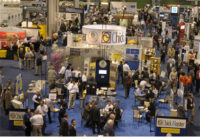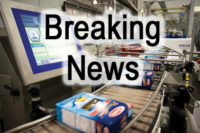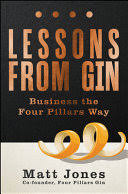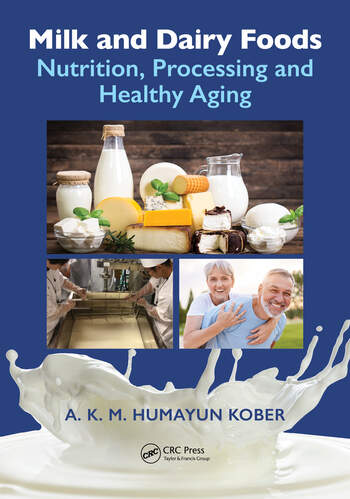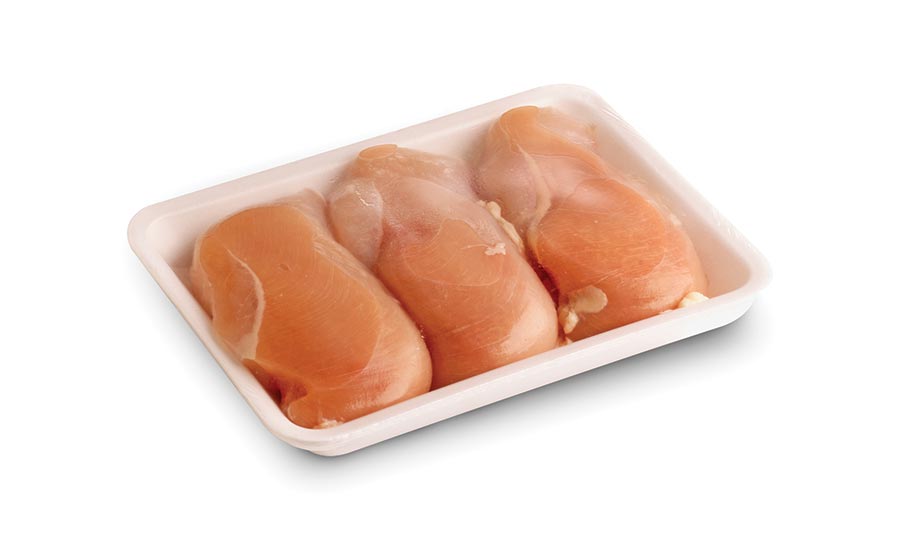Processing Technology
Poultry processing: Increased demand paves the way for innovation
As demand for chicken and turkey continues to rise, some processors are employing more technology to deliver safe and quality products.
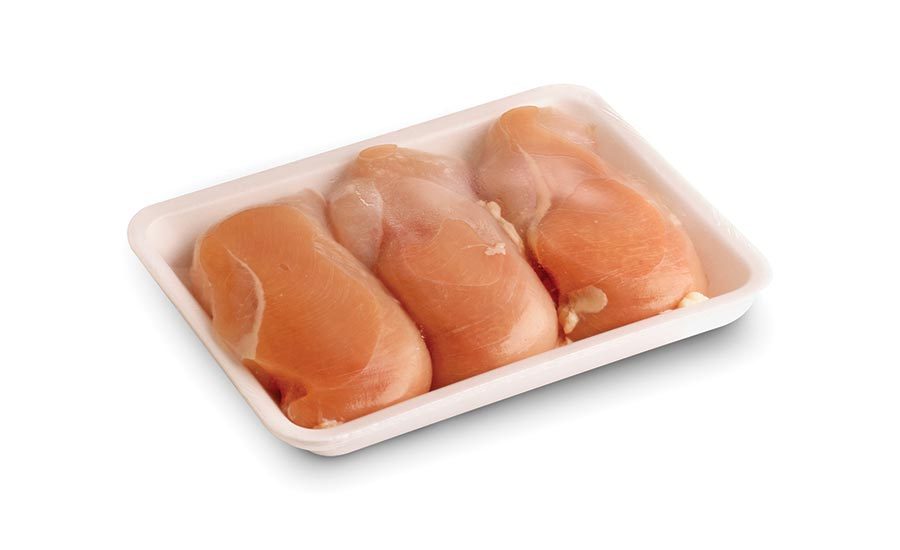
Novipax processor trays enable processed packaged food products to maintain visual, textural and nutritional appeal, while extending shelf life without chemical preservatives or stabilizers. Source: Novipax.

TraySkin from Sealpac is a transparent barrier film that seals the product directly in the tray. A second top film to create head space is optional. Source: Sealpac.

Meyn’s new shackle system makes it easier for health officials to evaluate the quality and safety of birds and bird parts more quickly during processing. Source: Meyn.

The Ossid OTS-10 table-top unit features a stainless steel design, manual or semi-automatic drawer feed, quick interchangeable tooling, print registration and more. Source: Ossid.

The METTLER TOLEDO X38 X-ray system inspects chicken pieces and other meats to ensure food safety before final packaging. Source: METTLER TOLEDO.





Poultry is a thriving, global industry. It’s been growing steadily over recent decades and is expected to continue growing as the world population increases, and more people are able to afford the high-quality, tasty and cost-effective protein that poultry can add to their diets.
Article Index:
- Advanced automation in the poultry plant
- CO2 stunning system
- Food safety
- X-ray use
- Poultry packaging
- Other side of the fence
- Sidebar: Food safety tips for poultry processors
- Sidebar: Steps to the dinner plate
Per capita consumption of poultry in the US has grown more than four times since the end of WWII. On a global scale, in 2015, the Food and Agriculture Organization of the United Nations predicted that poultry production will account for more than half of the world’s additional total meat output over the next decade compared to the 2012-2014 base-period average.
China is expected to take the lead, with an additional 5 billion tonnes of poultry by 2024. The US will be a close second, with a projected 4.75 billion additional tonnes, followed by Brazil with 2.8 billion tonnes, the EU with 1.5 billion tonnes and India with 1.1 billion tonnes.
Poultry definitely has its advantages. It has the shortest production cycle compared to other meats. This, together with expected continuing low grain costs, gives producers more production flexibility and an economic edge. And, as diets continue to shift toward more protein intake supported by steady global economic growth and rising incomes, poultry growth, thanks also to its healthy image and lower end price at retail, will be well supported into the future.
According to the USDA Economic Research Service, the price for chicken and turkey as of October 2016 was lowest compared to other major categories at $1.91 and $1.62 dollars per pound, respectively. Pork was $3.75; sirloin was $8.54; fresh beef was $5.77; and ground beef was $3.65, with prices in all categories remaining fairly stable over the previous 12 months.
Advanced automation in the poultry plant
The way production machines are computer controlled and talk to each other is crucial to the performance and success of every industrial company, including those that process poultry. CAT Squared of Conway, AR, specializes in software solutions for the food industry, including real-time reporting for production and inventory and farm-to-fork traceability.
In regard to preventing recalls, the CAT Squared system uses real-time serialized management of all received inventories—incoming raw spices, dry goods and meat—to track all movements within a facility.
“This approach enables our customers to know where their inventory is at all times and what individual items are being mixed together, what is being produced, what is being stored and where, and what is being shipped. This also allows for tight control over allergens and allows for the creation of tight recall windows,” says CAT Squared Marketing Manager Kathy Barbeire.
One of CAT Squared’s products that can save poultry and other producers a lot of money is the company’s Plant Floor Scoreboard system using its Food Safety and Quality Management (FSQM) software.
Case in point is Peco Foods Inc., a high-quality poultry products producer based in Tuscaloosa, AL. This company is a fully integrated grower, processor and marketer that produces 24 million pounds of poultry per week.
Peco’s quality assurance and production personnel, along with plant management, analyzed plant floor data in an effort to continuously improve their processes. Previously, all data was recorded manually and took a lot of time to compile. Human error further complicated the process. This meant that instead of knowing as soon as a failure occurred or a process was out of control, management had to wait at least a day or more to view the data, which sometimes cost a lot of money.
At that point, Peco turned to CAT Squared for a turnkey solution using its proprietary software, handheld devices, stationary touchscreen computers and 55-in. flat screen monitors, which collect and display any type of data, including weights, sizes, temperatures, defects, yield percents, HACCP, GMPs, pre-operational sanitation, downtime, metal detection checks and more.
“Our flat screen monitors are encased in IP69K-rated stainless steel anti-moisture enclosures and provide plant floor associates a clear view of real-time data,” says Barbeire. “We also included onsite training, weekly status reports and 24/7 support.”
After implementing CAT Squared’s solutions, downgrade product percentages improved immediately by more than 1.5 percent. Because Peco makes about 75 percent less revenue on downgraded product, the 1.5 percent improvement generated a 100 percent return on investment for the installation in a matter of months.
CO2 stunning system
Meyn America, LLC of Ball Ground, GA has a long history in all aspects of poultry production, from live bird handling, slaughtering and evisceration to chilling, cutting, weighing, packaging and more.
“Back in the ‘70s, Meyn was the first to launch a 180° evisceration unit onto the market,” says Scott Russell, Americas executive vice president sales and marketing. “Recent developments featuring advanced automation include the Meyn multi-stage CO2 stunning system, which incapacitates birds in the container before unloading, and the Meyn rapid deboner, which handles birds with or without wings and breast caps at 6,000 per hour.”
When Meyn developed its new CO2 stunning system (a co-development with Praxair Inc.), a lot of attention was given to animal welfare. Birds remain in the drawer or container during stunning, meaning the handling and transport of active birds is eliminated. This reduces handling stress and risk of injury. The closed cabinet construction allows for the CO2 concentration to be managed perfectly at every stage of the process. This ensures a humane stun and improves product quality.
In October, the company introduced the TDS thigh deboning solution M 1.0, which is based on a carousel principle and comes in three models, with capacities ranging from 3,600 to 7,200 thighs per hour.
“The units are able to reduce labor costs by up to 35 percent relative to competitive systems,” says Meyn Product Manager Jeroen Bohm, “while producing thigh filets that feature an outstanding level of presentation.”
The system includes a de-skinner and can separate kneecaps from the fillet, minimizing the risk of bone fragments. It also eliminates the need for trimming, reducing labor costs.
Meyn’s latest development is a high-speed evisceration line that can run at speeds up to 13,500 birds per hour. The previous limit was 12,000 bph, according to Product Manager Pete van Poorten.
“This enables us to meet customer expectations and helps them to achieve further efficiencies,” he says.
Food safety
Poultry, unfortunately, provides a good environment for the growth of microorganisms, including bacteria, such as Pseudomonas, Staphylococcus, Micrococcus, Acinetobacter and Moraxella. One of the most harmful pathogens that poultry is notorious for is Salmonella, which in some cases, has proven to be fatal, particularly among young, elderly and immune-challenged people.
That’s why it’s very important to be sure poultry is cooked to the right temperature inside and out, so bacteria, spores and pathogens are neutralized before the poultry is eaten. These days, a lot of care goes into the processing stage by manufacturers to mitigate these risks long before the birds reach the oven.
A paper put out years ago by the NCBI (National Centre for Biotechnology Information) is as relevant today as it was then. In an article entitled “Disinfecting Poultry Production Premises,” authors M. Meroz and Y. Samberg begin by stressing that hygiene and sanitation play major roles in any effective disease control program for poultry production premises.
“One of the important requirements to facilitate hygiene and sanitation is adoption of the ‘all-in/all-out’ method where all the birds in a single establishment should be of the same age group and be part of a single type or species,” say the authors.
They continue to explain that a poultry site must be prepared methodically for the entry of each new batch, including removal of birds; controlling litter and manure; eliminating rodents; dry and wet cleaning; disinfection; and fumigation.
“Regular visual inspection, together with routine testing by microbiological monitoring methods, is very effective in checking the efficacy of cleaning and disinfection,” they point out.
Food safety tips for poultry processors
Arvind Rao, North America food and beverage industry commercial manager for Rockwell Automation, lists what he considers to be best practices in the following important areas:
Food safety (i.e., addressing the bacterial issues, sanitation, track and trace methods in the event of a recall, etc.)
Poultry producers can better address food safety across their operations with an integrated control and information system. With integrated information and controls, producers can more efficiently and effectively monitor and record production. The resulting visibility and better recordkeeping can help producers gain a more accurate audit history and meet government regulatory requirements.
Sustainability
Poultry producers can improve their sustainability with better tracking and measurement of energy and water usage. They can leverage software that allows them to capture and analyze data on usage to better optimize consumption, manage power quality, correlate resource usage, determine the cost of production and improve efficiency.
Regulatory compliance (issues related to import/export, FSMA, GFSI, etc.) Implementing a supply chain track-and-trace system can help poultry manufacturers comply with emerging regulations, such as the increased traceability requirements expected in upcoming FSMA revisions. The system can also help manufacturers protect their products against supply chain diversions and conduct more efficient product recalls, if necessary.
Production
A lack of visibility and real-time reporting during production can pose potential food safety compliance risks. An integrated control and information platform based on standard industrial Ethernet protocols can provide enhanced control and visibility to operations to improve asset utilization and increase yield.
Customer service
In any food manufacturing sector, strong customer service and trust are key to business success. Manufacturers should implement the aforementioned best practices, so they can be ready to respond to any customer or public inquiry about food safety and other concerns.
X-ray use
A company on the leading edge of both weighing and inspection solutions is METTLER TOLEDO of Royston, UK. Among other things, this company specializes in a diverse range of product inspection solutions, such as X-ray systems for the food, beverage and pharmaceutical industries. In the meat, poultry and seafood segments, the company recommends its X38 Pipeline X-ray inspection system.
“Our main position in the inspection line is dictated by the customer’s internal HACCP analysis and the customer’s wishes to inspect the poultry at the raw pre-packaging or pre-dicing stage, because that’s where the best inspection sensitivity is obtained, particularly for bone,” says Paul King, METTLER TOLEDO’s head of sales. “We are basically an inspection point within the existing production line. The X38 X-ray system incorporates an automatic rejection mechanism, which diverts the contaminated product into a reject receptacle upon detection of bone, metal, glass and other contaminants.”
Regarding traceability, King says that the METTLER TOLEDO system is able to store an image of each reject with a time and date stamp in case of a recall and enables easy archiving and longer recordkeeping.
Regarding FSMA, GFSI and other standards, King says that rules for poultry are centered on reject security and due diligence features, including:
- Ensuring rejection takes place after detection. Additionally, the contamination receptacle should be locked with authorized access only.
- Ensuring multiple levels of security access to the various settings in the system.
- Ensuring that critical safety examinations are performed and that correct approvals are in place for the country of installation.
- Ensuring periodic equipment system checks for optimal operation. These tests should also be recorded in case of an audit.
Poultry packaging
OSSID of Battleboro, NC launched its new OTS-10VMAP table-top tray sealer at PACK EXPO 2016 in Chicago. It’s designed to meet the production requirements of small to medium-sized processors. The OTS-10 sealer is also ideal for larger processors involved in test marketing products for laboratory production of sample packaging.
It includes options for ambient, modified atmosphere packaging (MAP) and vacuum skin packaging (VSP) applications. Interchangeable tooling delivers fast changeovers between tray sizes. The units also feature rugged stainless steel construction for long service life.
“Our standard overwrap solutions are also popular and perform well in the protein industries,” OSSID's Vice President of Sales Jason Angel. “From PVC stretch to leak-proof packaging, we now have the ability to run both foam and plastic roll-edge trays. We developed our packaging technology together with our film partners over the last 20 years.”
The machines are easy to clean but, just as important, says Angel, is the fact that leak-proof seals enable grocery stores to maintain a clean shelf.
Located in Orangeville, Ontario, Trinamics produces a lineup of quality packaging machinery for food and beverage manufacturers. Recently, the company was asked to develop an integrated cartoner/case packer for a leading chicken processing company.
“In terms of production capacity, the customer wanted our solution to do more than keep up with their existing baggers,” says Trinamics Co-owner Barry Ryzebol. “They planned to introduce some off-skid product into the packaging line—and wanted to ensure they could ramp up overall production in the future as well.”
The Trinamics solution handles the pressed chicken product from the discharge point of two vertical form/fill/seal (VFFS) machines, where it is bagged, to the palletizers at the end of the line. Before the bagged product enters the cartoner, metering belts separate it, and conditioning hardware manipulates each bag. The bags are then deposited into the traveling buckets on the conveyor and taken to the carton load station where they are loaded into retail-ready cartons. Next, carton flaps are closed with melt adhesive.
Product then moves to the side-load case packer and next to palletizing. “There’s a high percentage of motion control hardware in this application,” Ryzebol explains. “In the old days, we handled that with mechanical gearboxes and line shafts. Now, it’s all servo technology, which achieves more consistent performance and reduces the number of maintenance points.”
The Trinamics equipment is based on a Rockwell Automation control system featuring Allen-Bradley Kinetix 5500 servo drives and Kinetix VPF food-grade servo motors. The servo control includes 27 total axes—14 for the cartoner and 13 for the case packer. All machine functionality is managed by an Allen-Bradley CompactLogix controller. The system also incorporates Allen-Bradley PowerFlex 525 AC drives to control the conveyance equipment. The solution is integrated on an EtherNet/IP network and monitored with Allen-Bradley PanelView Plus 6 graphic terminals.
In the end, Trinamics delivered a solution that met the customer’s budget and production requirements, while providing a 30 percent capacity buffer to meet future needs.
“At Trinamics, we start with a core design concept or machine model—and then tailor it to the application at hand,” Ryzebol explains. “Standardizing on a Rockwell Automation platform helps us establish consistent quality and [meet] customer expectations across the board.”
Other side of the fence
An aspect of poultry processing that’s equally important as what happens in the plant is what happens on the farm. In all industrial processes, the quality of the end product is directly related to the quality of the raw materials that go into making it. It’s no different with poultry.
Maintaining birds that are healthy and free from disease, of course, is the number one concern. If sick or contaminated birds are delivered to the processing plant, no manner of GMPs can improve their quality or make them safe to eat. That’s why there are sophisticated systems in place to detect and reject any sick birds, should they arrive at the back door.
“One of the tools that farmers have available to them to protect the health of birds is antibiotics,” says Lisa Bishop-Spencer, manager of communications at Chicken Farmers of Canada.
However, there is growing concern around overuse of antibiotics and its contribution to the proliferation of antimicrobial resistance, which is considered by health experts to be one of the most serious health threats to both animals and humans. In 2014, the USDA released its Antimicrobial Resistance Action Plan, which aims to “provide and disseminate science-based information to the veterinary and animal agricultural communities so they can implement effective mitigation strategies that will help to prolong the effectiveness of antibiotics for use in both animals and people.”
A few years before the US took action, the Chicken Farmers of Canada implemented its Antimicrobial Use Strategy, which aligns with the US federal government’s Action Plan on Antimicrobial Resistance and Use program.
The Antimicrobial Use Strategy focuses on defining antimicrobial use and antimicrobial resistance trends; reviewing best practices and reducing antimicrobial use; ensuring effective controls of antimicrobial use in Canada; researching and determining the availability of alternative products; and educating stakeholders on the issues of antimicrobial use and resistance.
“Chicken farmers have granted the government access to their farms, so that we can better understand these issues,” says Bishop-Spencer. “From this data, we have learned that the antimicrobials used most frequently in humans are not the same ones used in chicken production. The industry is working right now to evaluate further antibiotic use reduction that will help address the issue of resistance, while still ensuring the health of our birds.”
Steps to the dinner plate
Most chickens and turkeys take between seven and 14 weeks to harvest. The seven-weekers are young, tasty birds referred to as broilers or fryers, suitable for singles and small families. The 14-weekers are called roasters and are intended to feed a larger crowd. Regardless, they all have the same tale to tell regarding the special equipment used to process them.
Pre-slaughter
Birds are taken off feed and water before slaughter to reduce intestinal contamination. Cages are ventilated during transport, and cage areas are illuminated with red lights, which have a calming effect on the birds. Less stress means a better product.
Slaughter
Birds are stunned into unconsciousness by an electrical current or CO2 before they are killed by a mechanical rotary knife or by hand. They are then allowed several minutes to bleed out before the next step.
Scalding and de-feathering
Bird carcasses are scalded to prepare them for de-feathering. Special machines equipped with rubber appendages are used to remove the feathers. For some birds, such as waterfowl, waxing is used as well. Feathers are usually recycled into feather meal or down production.
Removing heads and legs
Heads and legs are removed mechanically and by the use of rotary knives. Carcasses are hung onto the eviscerating shackle line.
Evisceration
Removal of internal organs is done either by hand or automated machines. Cleaning of the machines is done using high amounts of chlorine.
Chilling
The carcasses are washed thoroughly and then chilled either by water or by air. Water chilling is more energy intensive than air chilling and adds weight to the meat, which is accounted for before the birds go to market. Air chilling, which is the standard in Europe, helps prevent cross-contamination between birds, but water chilling may be better overall because many bacteria and pathogens are washed away.
For more information:
Kathy Barbeire, CAT Squared, 501-328-9178 ext. 318,
Kathy.barbeire@catsquared.com, www.catsquared.com
Scott Russell, Meyn America, c/o Renate Munk, (31) 20-204-5156,
rmunk@meyn.com, www.meyn.com
Arvind Rao, Rockwell Automation, 440-646-3434,
avrao@ra.rockwellautomation.com, www.rockwell.com
Paul King, METTLER TOLEDO, c/o Paul Richlovsky, Fathom, 216-369-2220 ext. 234,
PRichlovsky@fathomdelivers.com, www.mt.com
Jason Angel, OSSID, 252-446-6177,
jangel@ossid.com, www.ossid.com
Lisa Bishop-Spencer, Chicken Farmers of Canada, 613-566-5911,
lbishop@chicken.ca, www.chicken.ca
Looking for a reprint of this article?
From high-res PDFs to custom plaques, order your copy today!




